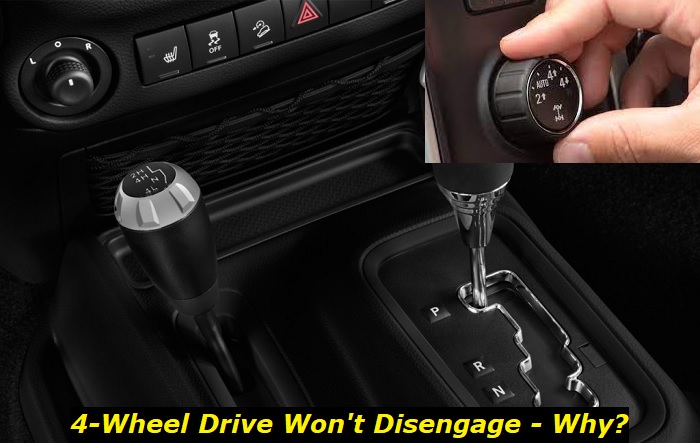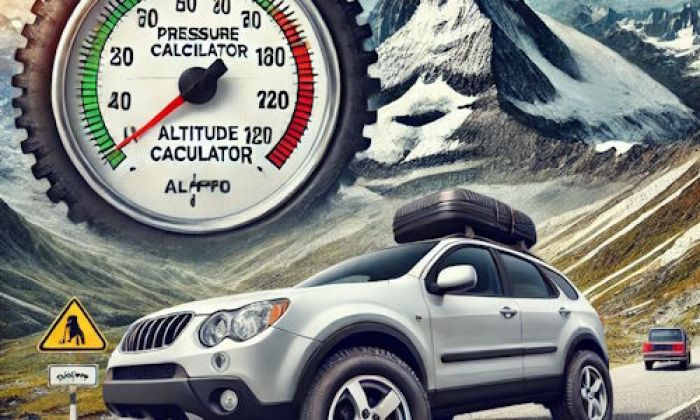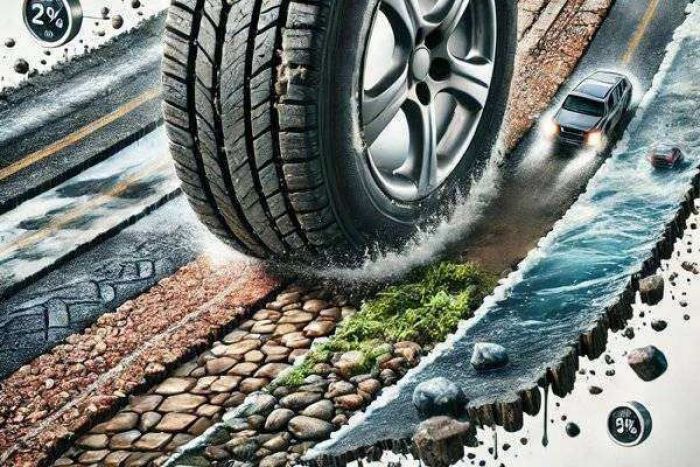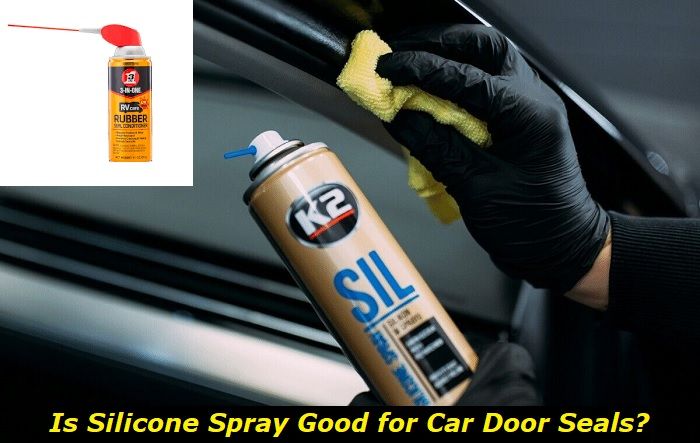The four-wheel drive system comes in handy when driving on an adventure offroad and into the wilderness. However, driving your vehicle on a smooth, dry surface like the highway while the 4WD is engaged is a different ball of wax as it can damage essential 4WD car parts. This article covers the common reasons why your 4-wheel drive won't disengage and ways to fix it to help you narrow down what the issue could be and prevent any further damage to your vehicle.

What is a Four-Wheel Drive, and Where Can You Use It?
A four-wheel drive, also known as 4x4 or 4WD, is a system in which the vehicle's engine provides power to all four wheels. Four-wheel drive is effective on particular types of roads which drivers find hard to navigate. Such roads are off-roads with rugged or slippery terrain, dirt roads, or roads that have snow or ice.
Four-wheel drive consists of 4H and 4L. One can use 4H when driving at normal speed (30-50 mph) but requires additional traction and security to power all four wheels. You can use this setting on roads covered with snow, hard-packed sand, or dirt roads. On the other hand, you can use 4L if you want to drive in super difficult driving conditions that require more torque.
When you use the 4L setting, more power is sent to the driven wheel since you lower the gear ratio. You can use 4L when driving on muddy roads, climbing rocky hills, or towing a heavy road on the highway.
Should You Drive Your Vehicle When the 4-Wheel Drive is Not Disengaging?
When the driver switches from the normal 2WD to 4WD, power is split between the four car wheels to provide enough stability, traction, and control to cruise on uneven terrain. However, the 4wd mode shouldn't be used on smooth, dry, and even surfaces since it can decrease fuel efficiency and damage the car's tires, differential, axle, or transfer case. That's why it's prudent to visit the nearest auto mechanic shop once you discover that your 4WD won't disengage.
How to Engage or Disengage the 4WD System
Engaging or disengaging the four-wheel drive system depends on your vehicle's brand. The older 4x4 versions need manual engagement while the vehicle is not in motion and the transmission is in neutral or park mode. For recent versions, you have the benefit of engaging the 4WD system with the push of a button.
More advanced versions also engage the four-drive system automatically by detecting when your truck needs more traction. When the 4WD system fails to engage or disengage, a "Service 4WD System" message may appear on the dashboard.
Causes of the Four-Wheel Drive Not Disengaging
Like other systems, faults in various components that allow the 4WD components to run may lead to the 4WD not disengaging. Some of the reasons why the 4-wheel drive may not disengage are:
1) Bad Switch
A selector switch's work is to allow switching between the 2WD and the 4WD. When the selector switch becomes faulty, your truck can fail to engage or disengage the four-wheel drive. Various symptoms that signal that the switch is not working include:
- 4WD fails to engage.
- The car frequently disengages from 4WD without the driver's input.
- The vehicle is stuck in 4WD mode.
- Difficulty in switching between the gears.
- Grinding noise as the truck cruises.
- A damaged electrical circuit.
2) Malfunction of the Transfer Case Control Module
The transfer case control module (TCCM) controls how the four-wheel drive operates by processing and executing shift motor speed, completing the 4WD shifting operation. You can find the transfer case control module on the steering column on the driver's side dashboard. When the control module becomes faulty, there's no power that goes to the transfer case.
Common Symptoms of a Faulty transfer case motor:
- An awkward humming or grinding noise comes from the transfer case as the truck accelerates.
- Issues with the shifting gear.
- The truck finds it difficult to stay in 4WD.
- The "4WD Service Required" message illuminates on the dashboard.
- Fluid leaks to form a puddle under the transfer case.
3) A Defective Vacuum Solenoid
The solenoid is a vacuum switch determining which axles are powered and running the differential locks. It releases the vacuum to the actuators and engages the hub. The solenoid can fail due to electrical energy that may damage the solenoid coil or when an incorrect voltage passes through the coil. The most common causes of a defective vacuum solenoid are damage by high temperatures, dirt or grease, a faulty vacuum pump, or a damaged connection hose.
Common Symptoms of a bad vacuum solenoid:
- 4WD refuses to engage or disengage.
- A declined engine performance where the vehicle lacks sufficient power.
- Hesitation.
- The vehicle remains in limp mode.
4) A Faulty Actuator
The actuator is an electronic component that engages or disengages the 4WD system. Once the driver engages the four-wheel drive through the switch, the actuator locks the differential. The axle actuator works harmoniously with the transfer case sending torque to the vehicle's four wheels.
Older vehicles used pressurized vacuum hoses to activate the gears and lock differential, but the newer models use an electronic solenoid to perform the same functions.
Symptoms of a faulty actuator:
- A decline in fuel economy.
- Frequent hesitation of the throttle response.
- Engine stalling.
- 4WD light comes on.
5) Seized Differential
The differential allows the vehicle's wheels to spin at different speeds. If the wheels were to rotate at similar speeds, there would be a strain on the axle, preventing the car from turning. A 4WD truck possesses both the front and rear differential to supply torque to all four wheels.
New models have the option of locking the differentials with just a press of a button, as opposed to older versions which the driver had to lock the hubs manually. The causes of the seized differential are water entry through seals or valves due to driving in a high water level and using the wrong type of lubricant.
Symptoms of a damaged differential:
- Insufficient lubrication due to leakage.
- Imbalanced driveshaft.
- Worn u-joints.
- Worn carrier bearings
- Worn pinion bearings.
- Broken cornering gears
- Worn cornering gears.
- Rattling or whirring noise.
6) Low Fluid Level
For the 4WD system to function properly, the transfer case and the differential oil should always be sufficient. The oil acts as a lubricant and a coolant for the differential gears. With time, the oil becomes bad since it's prone to breaking down and can also be contaminated by dirt and water. The reasons why the oil would break are:
- Constant driving on offroad tracks that are rough or wet.
- Frequent driving on a road with boggy mud, deep snow, or thick sand.
The oil can also become insufficient due to leakage. When the oil is contaminated or breaks down, it can no longer lubricate the differential and other 4WD parts, causing high friction, metal chaffing, grinding, and whirring noise when the truck is cornering.
Symptoms of a low fluid oil level:
- Paddles of oil under the differential or transfer case indicate oil leakage.
How to Fix the 4WD not Disengaging
The following are some of the fixes to a four-wheel drive system that's not disengaging:
Some quick fixes you can try are:
- Disconnecting and reconnecting the battery.
- Pressing the brake pedal down as you switch from 4WD low to 4WD high. Ensure that your truck is in neutral.
- Push the 4WD button that engages the four-wheel drive high mode. Ensure your truck is in neutral gear if it's not an automatic 4WD model. Put your car in reverse for 100 yards. Running the drivetrain in the opposite direction releases tension build-up. This will allow you to switch to 2WD.
Other fixes are:
- Regularly inspect and lubricate the moving components inside the actuator, like the locking collar, shift fork, and gears, to offer protection against moisture that may cause damage. Replace the actuator if damaged.
- If the switch is damaged, you need the services of a professional auto electrician to inspect or test if the switch needs replacement. Replace the switch if it can't be fixed.
- If the differential or transfer case oil level is low, you need to inspect for leaks before and after an offroad trip. It would help if you fixed the oil leaks before you can top up with new oil. Old or contaminated oil needs to be drained and replaced with new oil.
- You can fix most of the differential issues by changing the differential oil to have parts like pinion gears, ring gears, and axle bearings operating without any issues. If the differential is badly damaged, you need a new differential.
- To ensure that the 4x4 system is not affected by faulty electrical wiring, you should clean the electrical wires and spray them using an electrical silicon spray to ensure that they prevent moisture build-up.
Bottom Line
There you have it-the common causes of why your four-wheel drive won't disengage and their fixes. If you cannot fix the issues yourself, visit a trusted automobile repair shop to have your vehicle properly diagnosed and fixed by experts. It's also advisable to engage your 4x4 system once a month to keep it lubricated and prevent it from turning faulty.
About the authors
The CarAraC research team is composed of seasoned auto mechanics and automotive industry professionals, including individuals with advanced degrees and certifications in their field. Our team members boast prestigious credentials, reflecting their extensive knowledge and skills. These qualifications include: IMI: Institute of the Motor Industry, ASE-Certified Master Automobile Technicians; Coventry University, Graduate of MA in Automotive Journalism; Politecnico di Torino, Italy, MS Automotive Engineering; Ss. Cyril and Methodius University in Skopje, Mechanical University in Skopje; TOC Automotive College; DHA Suffa University, Department of Mechanical Engineering






Add comment